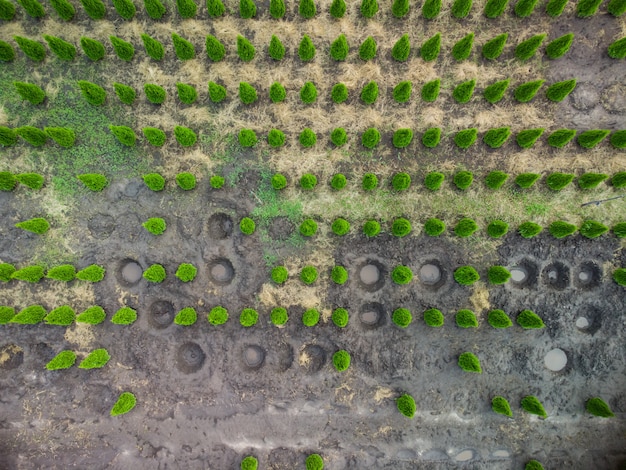Carbon Offsetting in the US: Project Effectiveness & Climate Impact

Carbon offsetting in the US involves projects that aim to reduce greenhouse gas emissions to compensate for emissions elsewhere, but their effectiveness varies greatly depending on project type, implementation, and verification methods.
The urgency of climate change demands innovative solutions, and carbon offsetting has emerged as a prominent strategy. In the US, understanding the role of carbon offsetting in the US: evaluating the effectiveness of different projects in mitigating climate change is crucial for informed decision-making and impactful environmental action.
Understanding Carbon Offsetting
Carbon offsetting, at its core, aims to neutralize the impact of greenhouse gas emissions by compensating for them through equivalent emission reductions or removals elsewhere. It’s a mechanism that allows individuals, organizations, and governments to invest in environmental projects to balance their carbon footprint. However, the concept is not without its complexities and challenges.
The fundamental idea behind carbon offsetting is relatively simple: if you emit one ton of carbon dioxide equivalent (CO2e) into the atmosphere, you can “offset” it by supporting a project that reduces or removes one ton of CO2e from the atmosphere. This creates a net-zero impact, at least in theory. But the devil is in the details. Evaluating the effectiveness of different carbon offsetting projects requires a deep dive into their methodologies, verification processes, and long-term impacts.

In the US, carbon offsetting has gained traction as a tool for businesses to meet sustainability goals, for individuals to mitigate their personal carbon footprints, and for governments to support climate action initiatives. But with a wide array of offsetting projects available, it’s essential to critically assess their true environmental benefits and ensure that they deliver on their promises.
The Mechanics of Carbon Offsetting
Carbon offsetting works by creating a market for carbon emissions reductions. Projects that reduce or remove carbon dioxide from the atmosphere can generate carbon credits, which are then sold to entities looking to offset their emissions. These projects can be categorized in various ways, including by type (e.g., forestry, renewable energy, carbon capture) and by location (e.g., domestic vs. international). The price of carbon credits varies depending on the project type, its location, and the perceived quality of the offset.
The Role of Standards and Certification
To ensure the integrity of carbon offsetting, independent standards and certification bodies play a crucial role. These organizations develop methodologies for quantifying emission reductions, verify that projects meet specific criteria, and issue carbon credits. Some of the most well-known standards include the Verified Carbon Standard (VCS), the Gold Standard, and the Climate Action Reserve (CAR). These standards provide a level of assurance that the projects are legitimate and that the claimed emission reductions are real.
- Additionality: Ensuring that the emission reductions would not have occurred without the carbon offset project.
- Leakage: Preventing emission reductions in one area from being offset by increased emissions elsewhere.
- Permanence: Verifying that the emission reductions are long-lasting and not easily reversed.
- Verification: Regularly auditing and verifying the emission reductions by an independent third party.
Understanding the principles and mechanisms of carbon offsetting is essential for evaluating the different types of projects and assessing their potential to contribute to climate change mitigation efforts. Robust standards and certification processes are critical to ensuring the integrity and effectiveness of carbon offsets. The US market for carbon offsets is evolving, and a deeper understanding of these fundamental concepts is necessary for navigating this complex landscape.
Types of Carbon Offsetting Projects in the US
The US boasts a diverse range of carbon offsetting projects, each with its unique approach to reducing or removing greenhouse gas emissions. These projects can be broadly categorized into several types, including forestry, renewable energy, carbon capture and storage, and agricultural practices. Evaluating the effectiveness of these projects requires understanding their specific methodologies, potential benefits, and associated risks.
Forestry projects are among the most common and well-established types of carbon offsets. They often involve activities such as reforestation (planting new trees), afforestation (planting trees in areas where they did not previously exist), and improved forest management (practices that enhance carbon sequestration in existing forests). Renewable energy projects, on the other hand, focus on generating electricity from sources like solar, wind, and hydropower, thereby displacing fossil fuel-based energy production.
Forestry Projects
Forestry projects work by absorbing carbon dioxide from the atmosphere through photosynthesis and storing it in the trees and soil. However, the permanence of these carbon stores is a concern, as forests are vulnerable to wildfires, insect infestations, and other natural disturbances. Additionally, the additionality of some forestry projects can be challenging to demonstrate, as some forest management practices may have occurred even without the carbon offset funding.
Renewable Energy Projects
Renewable energy projects reduce greenhouse gas emissions by replacing fossil fuel-based energy sources with cleaner alternatives. These projects can range from large-scale wind farms and solar power plants to smaller-scale residential solar installations. The effectiveness of renewable energy offsets depends on the grid mix they are displacing and the lifecycle emissions associated with the construction and operation of the renewable energy facilities.

Other types of carbon offsetting projects gaining traction in the US include carbon capture and storage (CCS) and agricultural practices. CCS involves capturing carbon dioxide emissions from industrial sources and storing them underground, preventing them from entering the atmosphere. Agricultural practices, such as no-till farming and cover cropping, can enhance carbon sequestration in soils while also improving soil health and productivity.
- Reforestation: Planting trees on previously forested land.
- Improved Forest Management: Practices to enhance carbon sequestration in existing forests.
- Renewable Energy: Generating electricity from solar, wind, and hydropower.
- Carbon Capture and Storage (CCS): Capturing and storing carbon dioxide emissions from industrial sources.
- Sustainable Agriculture: Enhance carbon sequestration in soils.
In conclusion, the US carbon offsetting landscape is diverse, offering a range of project types with varying degrees of effectiveness and associated risks. Forestry projects, while common, must address concerns about permanence. Renewable energy projects face challenges related to grid integration and lifecycle emissions. Newer approaches like CCS and agricultural practices show promise but are still developing. A thorough understanding of these different project types is crucial for informed decision-making in the carbon offsetting market.
Evaluating the Effectiveness of Carbon Offset Projects
Evaluating the effectiveness of carbon offsetting projects is crucial to ensuring they genuinely contribute to climate change mitigation. This evaluation requires a rigorous assessment of several factors, including additionality, leakage, permanence, and verification. These factors serve as benchmarks against which the integrity and impact of carbon offset projects are measured.
Additionality refers to the principle that a carbon offset project should only be credited for emission reductions that would not have occurred in the absence of the project. This is a fundamental requirement to prevent projects from being rewarded for actions they would have undertaken anyway. Leakage, on the other hand, addresses the potential for emission reductions in one area to be offset by increased emissions elsewhere. For example, protecting a forest from logging in one region might simply shift the logging activity to another region.
Additionality: Ensuring Real Impact
Additionality is often the most challenging aspect of carbon offset project evaluation. Demonstrating that a project is truly additional requires establishing a baseline scenario of what would have happened without the project and proving that the project’s activities are beyond business-as-usual practices. This often involves complex modeling and analysis, and the process can be subjective.
Leakage: Addressing Unintended Consequences
Leakage can undermine the effectiveness of carbon offset projects if not properly addressed. Projects must implement measures to prevent or minimize leakage, such as establishing buffer zones around protected areas or implementing sustainable forest management practices across a wider region. Monitoring and verifying these measures are is essential to ensuring that the projects deliver net positive emission reductions.
Permanence is also critical. Carbon stored in forests or soils can be released back into the atmosphere through wildfires, deforestation, or changes in land management practices. Carbon offset projects must demonstrate that their carbon storage is long-lasting and not easily reversed. This often involves implementing measures to mitigate risks, such as fire prevention strategies or long-term monitoring programs.
- Additionality: Verifying that the emission reductions are additional.
- Leakage: Preventing emission reductions in one area from causing increased emissions elsewhere.
- Permanence: Ensuring long-lasting carbon storage that cannot be easily reversed.
- Verification: Regularly auditing & verifying the emission reductions by an independent third party.
Finally, verification by an independent third party is essential for ensuring the credibility of carbon offset projects. Verification involves an independent assessment of the project’s methodologies, data, and emission reductions. This helps to ensure that the project is meeting its claims and that the carbon credits it generates are valid. Robust and transparent verification processes are vital for building trust in the carbon offsetting market.
The Role of Government Policies and Regulations
Government policies and regulations play a significant role in shaping the carbon offsetting landscape in the US. These policies can influence the demand for carbon offsets, the types of projects that are eligible for crediting, and the standards that must be met to ensure the integrity of the offsets. The government’s involvement can range from establishing carbon pricing mechanisms to providing incentives for carbon sequestration projects.
One potential policy tool is a carbon tax, which would place a price on carbon emissions, thereby incentivizing businesses and individuals to reduce their carbon footprint. A carbon tax could also create a demand for carbon offsets, as entities subject to the tax might choose to offset their emissions rather than pay the tax. Another approach is a cap-and-trade system, which sets a limit on overall emissions and allows entities to trade emission allowances. This can also create a market for carbon offsets, as entities that exceed their emission limits might purchase offsets to comply with the regulations.
Federal Initiatives and Incentives
At the federal level, several initiatives and incentives support carbon sequestration and emission reduction projects. The US Department of Agriculture (USDA) offers programs that encourage farmers and ranchers to adopt sustainable agricultural practices that enhance carbon sequestration in soils. The Department of Energy (DOE) supports research and development of carbon capture and storage technologies. These federal efforts can stimulate the supply of high-quality carbon offsets.
State-Level Actions
Many states have also implemented policies to promote carbon offsetting and emission reductions. California, for example, has a cap-and-trade program that allows regulated entities to use carbon offsets to meet their compliance obligations. Other states have established renewable energy standards that require utilities to generate a certain percentage of their electricity from renewable sources. These state-level actions can drive demand for carbon offsets and support the development of innovative projects.
The regulatory framework surrounding carbon offsetting in the US is still evolving. There is ongoing debate about the need for more stringent standards and oversight to ensure the integrity of carbon offsets. Some argue that the current voluntary market is insufficient and that mandatory regulations are needed to drive widespread adoption of carbon offsetting and ensure that projects deliver genuine emission reductions.
- Carbon Tax: Placing a price on carbon emissions.
- Cap-and-Trade System: Setting a limit on overall emissions and allowing entities to trade emission allowances.
- Federal Programs: Incentivizing sustainable agriculture and carbon capture technologies.
- State Regulations: Promoting carbon offsetting through cap-and-trade systems and renewable energy standards.
Government policies and regulations are vital for shaping the US carbon offsetting market and ensuring the effectiveness of carbon offset projects. Carbon pricing mechanisms, federal incentives, and state-level actions can all drive demand for carbon offsets and support the development of innovative projects. As the carbon offsetting landscape continues to evolve, ongoing discussions about standards and oversight are essential for ensuring that carbon offsets deliver genuine environmental benefits.
Challenges and Criticisms of Carbon Offsetting
Despite its potential to mitigate climate change, carbon offsetting faces numerous challenges and criticisms. Concerns range from the difficulty of ensuring additionality and permanence to the potential for “greenwashing” and the ethical implications of allowing entities to continue emitting while claiming to offset their emissions. Recognizing these challenges is crucial for improving the effectiveness and credibility of carbon offsetting schemes.
One of the primary criticisms of carbon offsetting is the concept of additionality. As discussed earlier, additionality ensures that the carbon offset project leads to emission reductions that would not have occurred otherwise. However, proving additionality can be incredibly complex, leading to concerns that some projects are being credited for activities they would have undertaken anyway. This undermines the environmental integrity of the carbon offset and calls into question its true impact.
Ensuring Additionality and Permanence
Permanence is another major challenge. Carbon stored in forests or soils can be released back into the atmosphere through natural disturbances like wildfires or human activities like deforestation. Ensuring the long-term permanence of carbon storage is essential for carbon offsets to be effective, but it can be difficult to guarantee. Carbon offset projects must implement robust measures to mitigate these risks, but even then, there is always a risk of reversal.
Avoiding Greenwashing and Ethical Concerns
Carbon offsetting has also faced criticism for potentially enabling “greenwashing,” where companies use carbon offsets to create a false impression of environmental responsibility without actually reducing their own emissions. This can be particularly problematic if the carbon offsets are of low quality or if the companies continue to engage in environmentally damaging practices. The ethical implications of allowing entities to continue emitting while claiming to offset their emissions are also a subject of debate.
Furthermore, carbon offsetting can sometimes have unintended social and environmental consequences. For example, some forestry projects have been criticized for displacing local communities or harming biodiversity. It is crucial for carbon offset projects to consider these potential impacts and to ensure that they are implemented in a way that benefits both the environment and local communities.
- Additionality: Ensuring that the emission reductions are additional.
- Permanence: Verifying that carbon storage is long-lasting and cannot be easily reversed.
- Greenwashing: Avoiding the impression of false environmental responsibility.
- Unintended Consequences: Considering social and environmental impacts of carbon offsetting methods.
In assessing carbon offsetting, it is essential to consider its challenges and criticisms. Ensuring additionality, permanence, and ethical implementation are crucial for the effectiveness and credibility of carbon offset projects. By addressing these challenges appropriately, carbon offsetting can play a more significant role in mitigating climate change and promoting sustainable development.
Future Trends in Carbon Offsetting
The carbon offsetting landscape is poised for significant changes in the coming years, driven by technological advancements, evolving regulations, and increasing demand for high-quality offsets. Several trends are likely to shape the future of carbon offsetting, including the rise of nature-based solutions, the development of carbon removal technologies, and the integration of digital technologies to enhance transparency and accountability.
Nature-based solutions, which involve leveraging natural ecosystems to sequester carbon dioxide, are gaining increasing attention. These solutions include reforestation, afforestation, and improved forest management practices, as well as soil carbon sequestration through sustainable agriculture. Nature-based solutions offer the potential to not only reduce greenhouse gas emissions but also provide other environmental and social benefits, such as improved biodiversity and water quality.
Nature-Based Solutions and Carbon Removal Technologies
Carbon removal technologies, also known as negative emissions technologies, are also expected to play a more significant role in carbon offsetting. These technologies involve removing carbon dioxide directly from the atmosphere and storing it permanently. Examples include direct air capture (DAC), bioenergy with carbon capture and storage (BECCS), and enhanced weathering. While still in the early stages of development, carbon removal technologies could become essential for achieving net-zero emissions targets.
Digitalization and Improved Transparency
Digital technologies, such as blockchain and satellite monitoring, are being used to improve the transparency and accountability of carbon offsetting projects. Blockchain can provide a secure and transparent record of carbon credit transactions, while satellite monitoring can be used to verify the emission reductions achieved by forestry and agricultural projects. These technologies can help to build trust in the carbon offsetting market and ensure that projects are delivering on their promises.
Increasing regulatory scrutiny is also expected to shape the future of carbon offsetting. Governments around the world are developing more stringent standards and oversight mechanisms to ensure the integrity of carbon offsets. This includes measures to improve additionality, prevent leakage, and ensure permanence. As regulations become more robust, the carbon offsetting market is likely to become more transparent and reliable.
- Nature-Based Solutions: Leveraging natural ecosystems to sequester carbon dioxide.
- Carbon Removal Technologies: Removing carbon dioxide directly from the atmosphere.
- Digital Technologies: Improving the transparency through blockchain and satellite monitoring.
- Regulatory Scrutiny: Enhancing standards & oversight in the carbon offsetting market.
The carbon offsetting landscape is evolving to meet the challenges of climate change. As technology and regulations improve, so will the way carbon offsetting can be utilized for a better environmental and financial benefit in the US.
| Key Point | Brief Description |
|---|---|
| 🌱 Carbon Offsetting | Projects that reduce emissions to compensate for those made elsewhere. |
| 🌳 Forestry Projects | Reforestation and improved forest management for carbon storage. |
| ⚡ Renewable Energy | Replacing fossil fuels with solar, wind, and hydropower. |
| 🔄 Additionality | Ensuring emission reductions would not occur without the project. |
Frequently Asked Questions (FAQ)
▼
Carbon offsetting involves investing in projects that reduce greenhouse gas emissions to compensate for emissions produced elsewhere. These projects can range from reforestation to renewable energy investments and sustainable agricultural practices.
▼
The main types of carbon offset projects in the US include forestry projects (reforestation, afforestation), renewable energy projects (solar, wind), carbon capture and storage, and agricultural practices that enhance soil carbon sequestration.
▼
The effectiveness of carbon offset projects can be evaluated based on factors like additionality (ensuring genuine emission reductions), leakage (preventing emissions shifting elsewhere), permanence (long-term carbon storage), and verification by independent third parties.
▼
Government policies influence carbon offsetting through carbon taxes, cap-and-trade systems, federal programs (like those from the USDA), and state-level regulations, which incentivize projects and ensure integrity through standards and oversight.
▼
Criticisms include difficulties in ensuring additionality and permanence, concerns about greenwashing (false environmentalism), and considering unintended social/environmental consequences. Addressing these issues is vital for fostering credible and effective carbon offsets.
Conclusion
In conclusion, the role of carbon offsetting in the US: evaluating the effectiveness of different projects in mitigating climate change, is complex. While challenges exist in ensuring additionality, permanence, and ethical implementation, carbon offsetting remains a vital tool in mitigating climate change. As technology and regulations improve, the carbon offsetting landscape is evolving to meet the challenges of climate change. By addressing these challenges appropriately, it can play a more significant role in creating a sustainable future.





